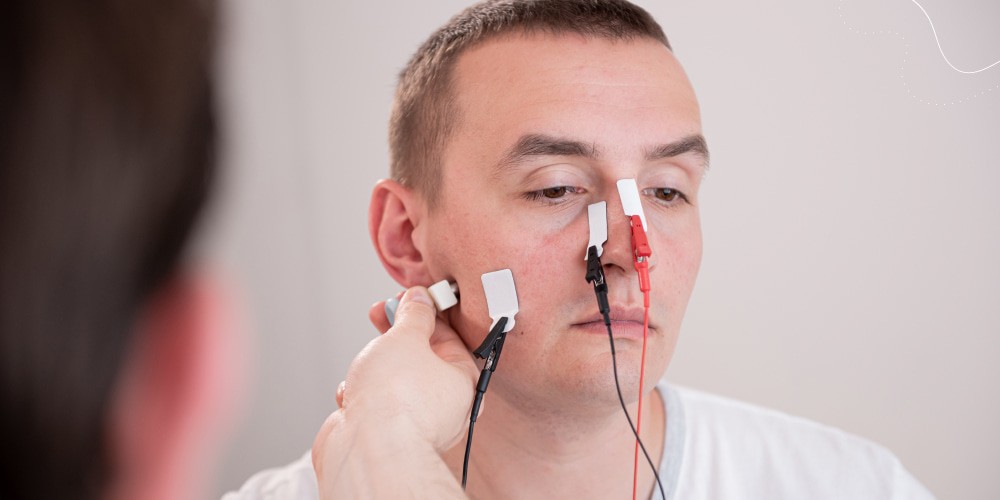The beauty of our face is an important aspect in the life of every person. We pay attention to beautiful facial features, read emotions using facial expressions, and analyze and communicate using our faces.
The facial nerve is responsible for how our emotions are displayed and how the muscles on our face work. A beautiful smile, dimples on the cheeks, and other cute things that we can do with our facial muscles are achieved through this nerve. However, at some point, everything may not go according to plan and the work of this nerve may be disrupted. This can lead to spasms and unnatural facial expressions.
Do you experience spasms and muscle twitches on one side of your face? If this phenomenon continues for a long time and with frequent attacks, there is a reason for this, which, as a rule, lies in the sensitive nerve fibres in the skull area.
Hemifacial Spasm Diagnosis
The cranial nerves, which also include the facial nerve, run from their origin to the organ they are responsible for through bones and various organs such as blood vessels, bones, and tissues. In some cases, and for reasons still unclear, there may be a physical collision between the nerve and these objects, which puts pressure on the nerve and, over time, leads to its dysfunction. When this situation occurs with the facial nerve, twitching of the facial muscles can develop, in most cases on one side only, which can develop into a serious aesthetic or even medical problem such as hemifacial spasm.
There is no single test that can diagnose this disease. Instead, the diagnosis relies on a combination of medical history, physical examination, and imaging tests:
Medical History
Your doctor will ask about your symptoms and when they started. They will also ask about your medical history, including any previous injuries or illnesses that could be related to your current condition.
Physical Examination
Your doctor will examine your face for signs of muscle twitching or spasm. They will also check for any weakness or paralysis in the affected muscles.
Imaging Tests
Imaging tests may be ordered to rule out other conditions that could cause similar symptoms. These tests may include magnetic resonance imaging (MRI), computed tomography (CT), or electromyography (EMG).
To live a full life and not experience discomfort due to spasms in your face, you should go through all the necessary procedures to determine your disease. Thus, a correct diagnosis can provide up to 50% of your treatment success. Indeed, your chances of success from a timely diagnosis can significantly increase. If you think you may have HFS, see your doctor for an evaluation.
Ways to Treat Hemifacial Spasm
The cause of HFS is unknown, but it is probably because of a problem with the facial nerve or brainstem. The condition is not life-threatening, but it can be painful and debilitating. In some cases, it can lead to social isolation and depression. There is no cure for hemifacial spasms, but there are treatments that can help lessen the symptoms.
If you’re dealing with this condition, you’re probably wondering what your treatment options are. In this block, we’ll go over all the treatments for hemifacial spasms, so that you can make an informed decision about which one is right for you.
There are three main types of treatments for muscle spasms in the face: medical, surgical, and electrical. Let’s take a look at each one in more detail.
Botulinum Injections
Several different types of medication can be great for treating HFS. Botulinum toxin injections are the most common type of medical treatment for hemifacial spasm. They work by temporarily paralyzing the facial muscles that are affected by HFS.
Other Medications
Other types of medication that help to treat muscle spasms in face include: anticonvulsants, calcium channel blockers, and steroids. However, these medications are not as effective as botulinum toxin injections and often have more side effects.
Surgery
Surgery may be an option if medical treatments don’t work or stop working over time. The most common type of surgery for hemifacial spasms is microvascular decompression (MVD). MVD is a procedure in which the surgeon moves the blood vessels that are pressing on the facial nerve away from the nerve. This relieves the pressure on the nerve and prevents HFS from occurring. Other types of surgery for hemifacial spasm include rhizotomy (a procedure in which the surgeon cuts some of the facial nerves) and pallidotomy (a procedure in which parts of the brain that control movement are destroyed).
Electrical Stimulations
The doctor places a device under your skin near the affected facial nerve. The device sends electrical impulses to the nerve and helps prevent muscle contractions.
LoneStar Neurology as Your Healthcare Provider
To always feel your best, you should carefully monitor your state of health and, at the slightest negative change, seek help from a specialist. So, in our clinic, you will receive the proper course from a team of professionals, the correct diagnosis, timely treatment, and affordable medicine. Simply call the number 214-619-1910 or use the contact us button.
Bottom Line
You can treat hemifacial spasms in a number of different ways. Surgery to release the nerve that is causing the spasm is typically the best course of action. However, a number of nonsurgical therapy approaches may work in some cases. Talk to your doctor about all of your treatment choices for hemifacial spasms and which one is best for you.
FAQs
- Can I treat hemifacial spasms naturally?
Many natural treatments are effective in treating the symptoms of hemifacial spasms. These include things like acupuncture, massage, and meditation. Talk to your doctor about whether or not these treatment options might be right for you.
- Does ice help hemifacial spasms?
There is no clear evidence that ice helps relieve hemifacial spasm symptoms. However, some people find that it helps to reduce the swelling and inflammation associated with the condition. If you want to try using ice, talk to your doctor first to ensure it is safe for you.
- Should I see a doctor for hemifacial spasms?
If you are experiencing any symptoms of hemifacial spasm, it is essential to see a doctor so that they can properly diagnose and treat the condition. There are several treatment options available, and your doctor can help you find the one that is right for you.
- How fast does hemifacial spasm progress?
The rate at which hemifacial spasm progress can vary from person to person. In some cases, the condition may only last for a short period and then go away on its own. In other cases, it may persist for many years. If you have a hemifacial spasm, talk to your doctor about how long it is likely to last and what treatment options are available.













Please, leave your review
2 Comments
Naneth Bickerstaff
05/11/2023
Thank you for the info.. How I wish my hemifacial spasm will go away 😢
Koldendorf
16/11/2023
Me too! I’ve had mine since 2016. My son was 6 months old when it started. I wonder if it had something to do with the epidural.
Write a comment: